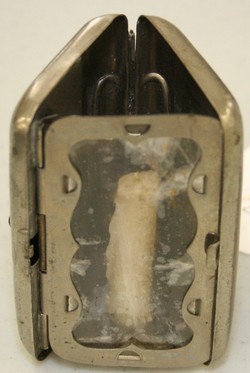By Julia Fell, ’17
Before the advent of portable electricity, those who needed to work at night or in dark conditions used the forerunner to a modern flashlight: a folding pocket lantern. An example of one of these lanterns is housed in the New York State Historical Association collections.

Folding Pocket Lantern, Nickel or Tin Plated Steel, Mica, and Paint, L: 4.5 in. x W: 3 in. x H: .75 in. The New York State Historical Society, Cooperstown, NY. Gift of Mrs. L. Franklin Messer, Buffalo, NY. N687.42, Photograph by Julia Fell.

Nickel Plated Folding Pocket Lantern, France, 18th Century. From prices4antiqes.com
This particular lantern is a 3-sided model. Though many pocket lanterns were 4-sided, other triangular versions exist.[1]
The NYSHA lantern is made of tin or nickel-plated steel; the shiny plating would have served to reflect the light inside when the lantern was closed. It is painted red on the outside, though much of the paint has now worn away. Other examples, cited below, categorize the red paint as “japanning.” The panel which becomes the front of the lantern when all of the flaps are properly connected, has a slice of mica (or “isinglass”)[2] for a window. Mica is a mineral, which when thinly sliced is transparent and provides protection from, and for the flame without the weight or break-ability of glass. This lantern has a flat triangular top with a hole covered by a curved piece of metal which serves to disperse the smoke while still allowing for ventilation. The bottom features a circular holder for a candle.
Most folding pocket lanterns are dated from the 18th or 19th century. Other 3-sided lanterns are estimated to be from the 18th century. Another similar lantern, from the Museum of London, is dated 1800-1835.[3] Other red-painted examples date to the mid-19th century.[4] [5] There is a patent for one of these red painted lanterns for 1865.[6] This gives a fairly wide range of dates for the NYSHA lantern; anywhere from 1700 to about 1870.

Lancaster’s Patent Ruby Lamp, from Christoper Clarke Antiques, campaignfurniture.com
What might these lanterns have been used for? All sources seem to indicate military use. The small lanterns could fold down and easily be carried in a pocket when not in use and on the go. They were easy to set up, and most models, including the NYSHA example, had clamps or slots for an extra candle and matches. A surprising use for these types of lanterns was to provide light in temporary photographic dark rooms, such as those that might have been used by military photographers. Though the NYSHA lantern has a clear mica window, other examples have dark red panes, which would have provided enough glow to see by when developing photos, but not enough direct light to damage the negatives.[7]
[1] “Lantern; Candle, Pocket, Nickel Plate & Leather, Folding, French.” Prices4Antiques. Accessed December 22, 2015. http://www.prices4antiques.com/Lantern-Candle-Pocket-Nickel-Plate-Leather-Folding-French-D9692359.html.
[2] “Isinglass.” Dictionary.com. Accessed December 22, 2015. http://dictionary.reference.com/browse/isinglass.
[3] “Pocket Lantern: 19th Century, Watts Arthur.” Museum of London Prints. Accessed December 22, 2015. http://www.museumoflondonprints.com/image/141839/watts-arthur-pocket-lantern-19th-century.
[4] “19th C. Traveling Lantern.” Dig Antiques. Accessed December 22, 2015. http://www.digantiques.com/search?q=lantern#details.
[5] “Antique Primitive Tin Metal Candle Lantern Hand Cut Tin Fold Up Mica Windows.” EBay. Accessed December 22, 2015. http://www.ebay.ca/itm/Antique-Primitive-Tin-Metal-Candle-Lantern-Hand-Cut-Tin-Fold-Up-Mica-Windows-/161922894194?hash=item25b35b4972:g:7vwAAOSwHPlWdY9-.
[6] [6] “MINOR’S PATENT TIN FOLDING POCKET LANTERN DATED 1865 – Horse Soldier.” The Horse Soldier. Accessed December 22, 2015. http://www.horsesoldier.com/products/personal-items/10231.
[7] “Lancaster’s Patent Ruby Lamp.” Christopher Clarke Antiques. Accessed December 22, 2015. http://www.campaignfurniture.com/archivesdetailspage.asp?stockNo=81295&archive=1.